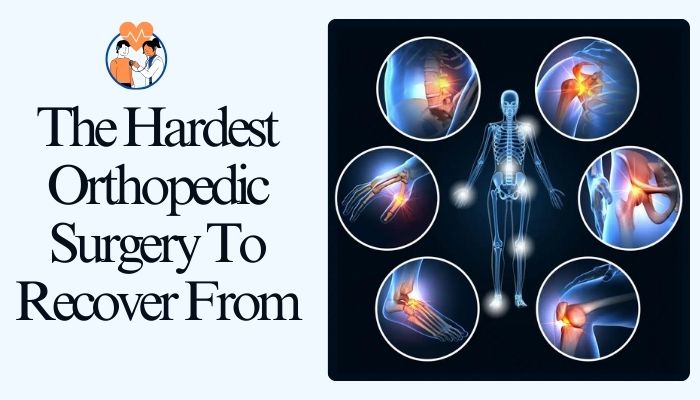What Is The Hardest Orthopedic Surgery To Recover From: Detail Information

is the cure for any injury or disease-destructive affliction affecting the human musculoskeletal system (muscles, tendons, ligaments, joints, and bones). Although some orthopedic surgery has been made easier with advances in medical technology, others are very challenging, whether because of the complexity of the procedure, the long recovery duration, or the physical and emotional burdens on a patient.
Among the few, few other surgeries that expose a patient to some of the most harsh conditions include spinal fusion surgery, total joint replacement (such as hip or knee), and some intricate fracture repairs.
Most Difficult Orthopedic Surgery To Recover Form
Orthopedic surgery can transform lifestyles that are full of chronic pain and mobility problems. There is no denying that recovery can be complex, especially where surgeries are very intricate. Explore challenging orthopedic surgeries and their demanding rehabilitation journeys.
Spinal Fusion Surgery
Spinal fusion surgery involves joining two or more vertebrae to eliminate movement between them. This procedure is often used to treat conditions like degenerative disc disease, scoliosis, or spinal instability.
Why It’s Challenging
-
Recovery can take six months to a year for patients undergoing spinal fusion surgery. At this time, they may be required to wear braces and have movement restrictions for weeks or months.
-
Postoperative pain may be excruciating, at times, particularly in the first few weeks of the recovery period.
-
Patients experience a degree of immobility in the fused part of the spine reducing movement possibilities in different daily activities.
-
The rehabilitation plan was organized to concentrate on securing surrounding muscle groups and on newly learned movement techniques.
-
Additionally, infection, dislocation, and blood clots are some probable risks during the recovery phase.
Helpful Advice During Recovery
Always follow your surgeon’s recommendations concerning movement limitations. Attend all of your physical therapy sessions to restore strength and mobility. Eat well to ensure that bones are healing properly.
Knee Replacement Surgery
The procedure involves replacing damaged cartilage and bone with a prosthetic joint. Such surgery is usually performed in cases of severe arthritis and also that of injury.
Why It’s Challenging
-
Physical therapy starts almost immediately after surgery because it plays a crucial role in getting back the range of motion and strength.
-
The first few weeks after surgery are often marked by heavy pain and swelling.
-
Therapy can be stopped in case of widespread scar formation that can negatively impact the flexibility of the knee joint.
-
These risks are the formation of blood clots and an infection that needs monitoring.
Helpful Advice During Recovery
You need to put great effort into physical therapy so that you can almost regain your full range of motion. Use devices like walkers or crutches whenever needed. Elevate and apply ice on the knee to bring down swelling.
Hip Replacement Surgery
In , the damaged hip joint is replaced with a prosthetic implant. The most common patients being treated are those suffering from- osteoarthritis, fractures, or avascular necrosis.
Why It’s Challenging
-
Patients must avoid certain movements to prevent dislocation of their new joint.
-
Commonly, pain accompanies recovery in the early stages, which may restrict activity.
-
Once the surgery is performed, the patient will need physical therapy to rebuild and mobilize strength.
-
A prosthetic joint may present emotional difficulties for the patient.
-
It has also the possibility of infection, dislocation, and blood clots that may delay recovery.
Helpful Advice During Recovery
Do not bend your hip more than 90 degrees or cross your legs. Perform the prescribed exercises to enable the strength of the surrounding muscles. Have regular follow-ups with your surgeon concerning your progress.
Complex Fracture Repairs
Fractures that invade multiple bones, joints, or the spine may require an extensive surgical approach to realign and stabilize the bones.
Why It’s Challenging
-
Complex fractures typically implicate damaged surrounding tissue, adding a further dimension of complexity to both the surgery and its succeeding recoveries.
-
Long periods in casts or braces lead to muscular atrophy or stiffness.
-
The recovery time is really painful.
-
In some occasions, the bones don’t heal properly and more procedures are needed.
Helpful Advice During Recovery
Complete immobilization instructions during the recovery period to reestablish healing. Gradually increase mobility through the use of physical therapy. Consume nutrient-rich foods for the repair of bone.
Factors That Make Orthopedic Surgeries Difficult to Recover From
An understanding of what creates a hurdle in recovery can be possible in the various surgical procedures. These include:
-
Commonly, procedures involving more than one structure such as bones, nerves, and ligaments take longer to recover.
-
It often entails limited movement during recovery, resulting in muscle atrophy and stiff joints.
-
Surgical pain is usually severe and requires thorough facilitation to prevent drug dependence while minimizing post-operative pain.
-
Most surgical treatments require rigorous and prolonged physical therapy to restore function.
-
Such factors include age, history of medical problems, and lifestyle, which will be critical to the recovery process.
-
Healing from these problems may be delayed by infections, blood clots, or other complications.
Emotional and Mental Challenges
The psychological aspect of recovery is often overlooked. Difficult orthopedic surgeries can often leave the patient feeling frustrated, anxious, or depressed due to extended periods of immobility and reliance on others. Thus, the coping strategies include: Accepting that recovery will occur gradually, Family, friends, or even support organizations offering encouragement, and celebrating those small milestones to maintain motivation.
Innovations to Ease Recovery
Advancements in surgical techniques and rehabilitation are continually improving outcomes. Minimally invasive procedures, enhanced pain management strategies, and robotics-assisted surgeries are reducing recovery times and improving patient satisfaction.
Conclusion
While many orthopedic surgical procedures are tough to recover from, expert techniques combined with careful rehabilitation can lead to successful outcomes. Spinal fusion, total joint replacements, and complex fracture repairs are some of the most stringent procedures to recover from, but it is possible to regain one’s quality of life using the right approach and positive mindset. Preparing mentally and physically for a procedure of these is the best way to go, coordinating with your healthcare team to provide you with a smoother recovery experience.




